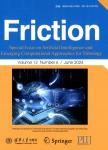Investigation of role of cartilage surface polymer brush border in lubrication of biological joints
Investigation of role of cartilage surface polymer brush border in lubrication of biological joints作者机构:Department of Infrastructure Engineering.The University of Melbourne.Victoria 3010Australia Faculty of Engineering and Mathematical SciencesThe University of Western AustraliaWA 6009Australia College of ScienceHealth.Engineering and Education.Murdoch UniversityWA 6150Australia
出 版 物:《Friction》 (摩擦(英文版))
年 卷 期:2022年第10卷第1期
页 面:110-127页
核心收录:
学科分类:08[工学] 080501[工学-材料物理与化学] 0805[工学-材料科学与工程(可授工学、理学学位)] 080502[工学-材料学]
基 金:This study was supported by the Australian Research Council(DP180100915) the Graduate Research Scholarship by the University of Melbourne
摘 要:Although experimental evidence has suggested that the polymer brush border(PBB)on the cartilage surface is important in regulating fluid permeability in the contact gap,the current theoretical understanding of joint lubrication is still *** address this research gap,a multiscale cartilage contact model that includes PBB,in particular its effect on the fluid permeability of the contact gap,is developed in this *** modeling is employed to estimate the permeability of the contact *** permeability is classified into two categories:For a gap size1μm,the flow resistance is assumed to be dominated by the cartilage roughness;for gap size1μm,flow resistance is assumed to be dominated by the surface polymers extending beyond the collagen network of the articular *** gap sizes of less than 1μm,the gap permeability decreases exponentially with increasing aggrecan concentration,whereas the aggrecan concentration varies inversely with the gap ***,the gap permeability is employed in a macroscale cartilage contact model,in which both the contact gap space and articular cartilage are modeled as two interacting poroelastic *** fluid exchange between these two media is achieved by imposing pressure and normal flux continuity boundary *** model results suggest that PBB can substantially enhance cartilage lubrication by increasing the gap fluid load support(e.g.,by 26 times after a 20-min indentation compared with the test model without a PBB).Additionally,the fluid flow resistance of PBB sustains the cartilage interstitial fluid pressure for a relatively long period,and hence reduces the vertical deformation of the ***,it can be inferred that a reduction in the PBB thickness impairs cartilage lubrication ability.



